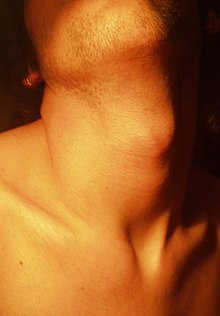Adam's apple
Adam's apple , Latin Prominentia laryngea or Pomum Adami , describes the clearly protruding and palpable section of the thyroid cartilage ( cartilago thyroidea ) of the larynx in men . In women, the prominentia laryngea is also present, but is much less developed. The stronger bulging in the male sex arises under the influence of androgens in puberty . This is where the thyroid cartilage grows more strongly in males, so that the vocal cords ( ligamenta vocalia ) become longer and the voice becomes deeper. The vocal folds increase about 1 cm in length within two to three months. This change in voice is known as a voice change or voice break and can last up to a year. The speaking voice decreases by about an octave.
etymology
The term "Adam's apple" goes one on the biblical story of the fall ATTACHING popular belief back. According to Adam, the forbidden fruit from the tree of knowledge - which in medieval art was mostly depicted as an apple - got stuck in Adam's throat when he ate from it; since then all men have been marked by this time. This legend can be found in variations throughout Europe since the Middle Ages; in the motif index of folklorist Stith Thompson it is listed under the code A1319.1. Although this mixture of folk and superstition was not supported by the biblical scriptures, the term Adam's apple or Latin Pomum Adami also seeped into medical terminology in the 16th century. It was used here until the 19th century, but was then replaced by Prominentia laryngea with the introduction of the Basel human anatomical nomenclature in 1895 .
Web links
Individual evidence
- ^ Anatomical nomenclature based on: Ian Whitmore (Ed.): Terminologia Anatomica. International Anatomical Terminology , Thieme, Stuttgart 1998, Sigle A06.2.02.003 (p. 58).
- ↑ Herbert Lippert: Anatomy at the bedside: physical examination and small interventions . 2nd Edition. Springer, Berlin 2013, ISBN 978-3-642-48408-7 , pp. 228 .
- ↑ Sabine S. Hammer, Anna Teufel-Dietrich: Voice therapy with adults: What voice therapists should know . 6th edition. Springer, Berlin 2017, ISBN 978-3-662-53977-4 , pp. 39 .
- ↑ Cf. Oskar Dähnhardt: Natursagen. A collection of natural legends, fairy tales, fables and legends , Volume 1, Leipzig 1907, pp. 208-211. ( online at zeno.org )
- Jump up ↑ Stith Thompson, Motif-Index of Folk-Literature: A Classification of Narrative Elements in Folktales, Ballads, Myths, Fables, Mediaeval Romances, Example, Fabliaux, Jest-books and Local Legends , Volume I, Rosenkilde, Copenhagen 1955.
- ↑ Axel Karenberg, Amor, Äskulap & Co: classical mythology in the language of modern medicine , Schattauer, Stuttgart 2006, pp. 128–129.

